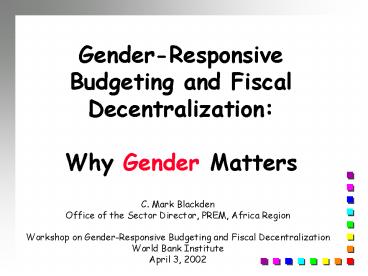Completing the Picture PowerPoint PPT Presentation
1 / 16
Title: Completing the Picture
1
Gender-Responsive Budgeting and Fiscal
DecentralizationWhy Gender Matters
C. Mark Blackden Office of the Sector Director,
PREM, Africa Region Workshop on
Gender-Responsive Budgeting and Fiscal
Decentralization World Bank Institute April 3,
2002
2
Outline
- Rationale for gender budgets
- Relevance of gender for budgeting
decentralization - socio-economic roles of men and women
- gender-based asset disparities (gender dimensions
of poverty) - policy implications
- engendering priority actions
3
Engendering Budgets - Why?
Budget as core instrument of policy, which
defines /or reflects priorities
Men and women have different roles, capacities,
access to resources, priorities
Economic policies (including budget) have
different impacts on men and women
Institutional role gender belongs in the
Ministry of Finance (Econ. Management)
4
Uganda Gender Intensity of Production
Source Based on Elson and Evers 1997.
5
The Double Workday of Women
Source Benin --Time Allocation Study, UNDP, 1998
6
Zambia Transport Tasks
Domestic Travel Time () Women Men
Other 96 1 3
18
63
19
2.35 hours per adult female per day
Source Christina Malmberg-Calvo. 1994, Women in
Rural Transport SSTP Working Paper No. 11.
World Bank and ECA.
7
Adult Illiteracy
Source World Development Indicators, 2001.
8
Men and Women in Parliament
Are women more or less well repre-sented at lower
levels?
Source International Parliamentary Union, 2001.
www.ipu.org.
9
HIV/AIDS Prevalence Rates by Age (15-24) and
Gender, Selected SSA Countries
HIV/AIDS Prevalence Rates by Age (15-24) and
Gender, Selected SSA Countries
Source UNAIDS, June 2000.
Source UNAIDS, June 2000. www.unaids.org
Source UNAIDS, June 2000.
10
Key Policy Implications 1
- Because, in gendered economies, disparities
persist in mens and womens access to and
control of human, economic, and social assets - gender-based inequality limits economic growth
and diminishes the effectiveness of poverty
reduction efforts.
11
Gender inequality and economic growth
- Cameroon Rice vs. Sorghum
- Women do not control the income from rice
production, and prefer the less remunerative task
of sorghum production where they control the
income. Total household income is lower than it
could be. - Burkina Faso Agricultural ProductionKey inputs
(fertilizer and manure) are unevenly distributed.
- IF existing resources were shifted between
mens and womens plots, output up by 10-20
12
Closing the gender gap in schooling boosts
economic growth
4
Actual growth rate
Projected growth rate
3
(percent)
Average annual growth in per capita GNP,
1960-1992
2
1
0
Sub-Saharan Africa
South Asia
Middle East/North Africa
Source Engendering Development (PRR) 2001, in
WDR 2000/01, Attacking Poverty.
13
Key Policy Implications 2
- Because household and market economies co-exist
are interdependent ... - trade-offs and linkages within and across
sectors are very significant
14
Engendering Priority Actions 1
- Gender as criterion for inclusive participation
in setting poverty reduction policy and budget
priorities ( local level) - gender-responsive budget (GRB) initiatives
- gender-based benefit incidence analysis
- gender inclusion in budget decisions (MTEF?)
- Gender as criterion for prioritizing expenditure
choices (agenda setting) - pro-poor growth targeting agriculture informal
sector (female-dominated sectors) - reorient research/extension, financial services,
production labor-saving technology
15
Engendering Priority Actions 2
- Concurrent investment in the household economy
reduces poverty and is highly relevant for growth
productivity - water/sanitation, domestic energy, transport
(IMT), labor-saving technology - Concurrent investment in gender-inclusive human
development - education, literacy, vocational skills
- health, nutrition, fertility
- grassroots management training (GMT)
16
Investments in water and fuel infrastructure
significantly reduce time on collection
activities
Water and fuel investments significantly reduce
collection time
Potential average annual time savings
Potable water within 400m
600
Woodlots within 30 mins walk
400
Annual time savings (hours per household)
200
0
Lusaka Rural
Kaya
Mbale
Kasama
Dedougou
(Zambia)
(Burkina Faso)
(Uganda)
(Zambia)
(Burkina Faso)
Kasama Dedougou already within the target for
water. Source Barwell 1996, in Engendering
Development, PRR, 2001.

